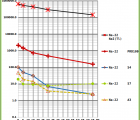Introduction: As the years of displacement accumulate, the burden of secondary stressors (i.e., stressors not directly related to war) increase on the shoulders of millions of refugees, who do not have the option of either returning home due to war or having a sustainable livelihood in the host countries. This paper aims to shed light on the overlooked importance of secondary stressors among refugees of conflict in developing countries; it will do this by highlighting the experience of Syrian refugees in Jordan, and developing a typology of these stressors.
Methods: We approached this issue using two levels of exploration. In study 1, we used participant observation and 15 in-depth interviews in Irbid, Jordan. Data were analysed qualitatively using thematic analysis to explore the different types of stressors. In study 2, a questionnaire survey among Syrian refugees in Jordan (n = 305) was used to collect data about a wide range of stressors. Responses were subjected to factor analysis to examine the extent to which the stressors could be organized into different factors.
Results: The thematic analysis suggested three different types of secondary stressors: financial (money related), environmental (exile structures and feelings created by it), and social (directly related to social relations). The factor analysis of the survey data produced a similar typology, where secondary stressors were found to be grouped into four main factors (financial, services, safety, and relations with out-groups). The final result is a typology of 33 secondary stressors organised in three main themes.
Discussion: Syrian refugees in Jordan suffer the most from financial stressors, due to loss of income and high living expenses. Environmental stressors arise from exile and are either circumstantial (e.g., services and legal requirements) or created by this environment (e.g., instability and lack of familiarity). Social stressors were observed among a considerable section of refugees, varying from stressors due to being targeted as a refugee by the locals (e.g., discrimination) to more traumatic stressors that came from both locals and other refugees (e.g., assault). The typology of secondary stressors suggested by the present analysis needs to be investigated in a larger sample of refugees of conflict in other countries in the Middle East, in order to determine its generality. We suggest that it is a basis for a framework for practitioners and academics working with refugees in the region.
Key words: Armed conflict, Syrian, Jordan, refugees, forced displacement, exile, daily stressors, secondary stressors, trauma, typology.


